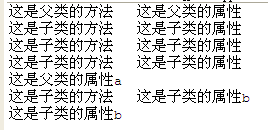动手实验:继承条件下的构造方法调用
运行 TestInherits.java 示例,观察输出,注意总结父类与子类之间构造方法的调用关系修改Parent构造方法的代码,显式调用GrandParent的另一个构造函数,注意这句调用代码是否是第一句,影响重大!

class Grandparent { public Grandparent() { System.out.println("GrandParent Created."); } public Grandparent(String string) { System.out.println("GrandParent Created.String:" + string); } } class Parent extends Grandparent { public Parent() { //super("Hello.Grandparent."); System.out.println("Parent Created"); // super("Hello.Grandparent."); } } class Child extends Parent { public Child() { System.out.println("Child Created"); } } public class TestInherits { public static void main(String args[]) { Child c = new Child(); } }
通过super调用基类构造方法,必须是子类构造方法中的第一个语句
思索:
为什么子类的构造方法在运行之前,必须调用父类的构造方法?能不能反过来?为什么不能反过来?
构造函数主要是用来在创建对象时初始化对象,即为对象成员变量赋初值。由于子类是继承父类的,所以创建子类对象时,必须先调用父类的构造方法,这样子类才能有父类的属性和方法。不能反过来是因为父类不知道子类有什么变量,而子类也得不到父类的初始化变量。
请自行编写发代码测试一下特性:
在子类中若要调用父类中被覆盖的方法,可以使用super关键字

class Parent{ public void method(){ System.out.println("这是父类"); } } class Child extends Parent{ public void method(){ System.out.println("这是子类"); super.method(); } } public class Override { public static void main(String [] args){ Child c = new Child(); c.method(); } }
运行截图:
程序运行结果是什么? 你如何解释会得到这样的输出? 计算机是不会出错的,之所以得 到这样的运行结果也是有原因的, 那么从这些运行结果中,你能总结出Java的哪些语法特性?
请务必动脑总结,然后修改或编写一些代码进行测试,验证自己的想法,最后再看 后面的PPT给出的结论。

public class ParentChildTest { public static void main(String[] args) { Parent parent=new Parent(); parent.printValue(); Child child=new Child(); child.printValue(); parent=child; parent.printValue(); parent.myValue++; parent.printValue(); ((Child)parent).myValue++; parent.printValue(); } } class Parent{ public int myValue=100; public void printValue() { System.out.println("Parent.printValue(),myValue="+myValue); } } class Child extends Parent{ public int myValue=200; public void printValue() { System.out.println("Child.printValue(),myValue="+myValue); } }
运行截图:

如果子类与父类有相同的字段,则子类中的字段会代替或隐藏父类的字段,子类方法中访问的是子类中的字段(而不是父类中的字段)。如果子类方法确实想访问父类中被隐藏的同名字段,可以用super关键字来访问它。如果子类被当作父类使用,则通过子类访问的字段是父类的。
当子类与父类拥有一样的方法,并且让一个父类变量引用一个子类对象时,对象是子类型的,它就调用子类型的方法,是父类型的,它就调用父类型的方法。

public class ParentChildTest { public static void main(String[] args) { Parent parent=new Parent(); parent.printValue(); Child child=new Child(); child.printValue(); parent=child; parent.printValue(); parent.myValue+="a"; parent.printValue(); System.out.println(parent.myValue); ((Child)parent).myValue+="b"; parent.printValue(); System.out.println(((Child)parent).myValue); } } class Parent{ public String myValue="这是父类的属性"; public void printValue() { System.out.println("调用父类的方法 "+myValue); } } class Child extends Parent{ public String myValue="这是子类的属性"; public void printValue() { System.out.println("调用子类的方法 "+myValue); } }
运行截图:

